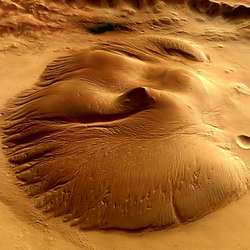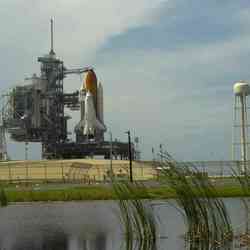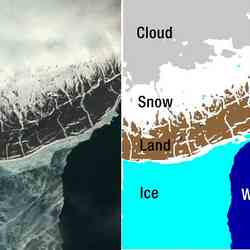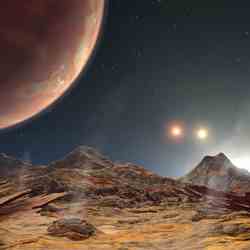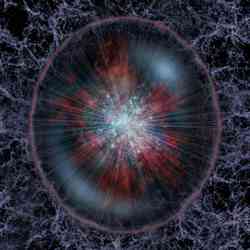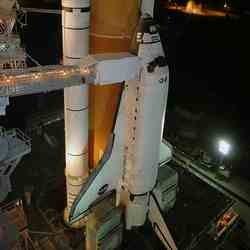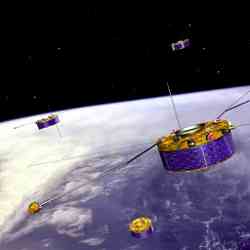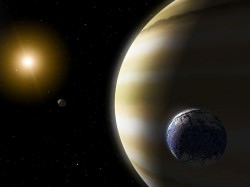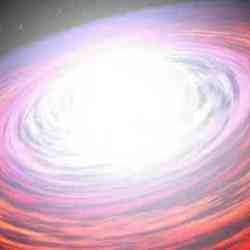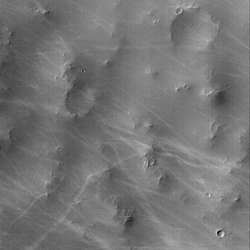
Dust devil tracks. Image credit: NASA/JPL. Click to enlarge
Ah, Martian summer! Finally, the days are long, just like on dear old Earth. And daytime highs rocket all the way up to a balmy 20?C (68?F) from the summer nighttime low of -90?C (-130?F), meaning you and your fellow astronauts can warm up your machinery earlier to get a good start on mining operations.
Dust devils on Mars form the same way they do in deserts on Earth. “You need strong surface heating, so the ground can get hotter than the air above it,” explains Lemmon. Heated less-dense air close to the ground rises, punching through the layer of cooler denser air above; rising plumes of hot air and falling plumes of cool air begin circulating vertically in convection cells. Now, if a horizontal gust of wind blows through, “it turns the convection cells on their sides, so they begin spinning horizontally, forming vertical columns–and starting a dust devil.”
Hot air rising through the center of the column powers the whirling air ever faster–fast enough to begin picking up sand. Sand scouring the ground then dislodges flour-fine dust, and the central column of hot rising air buoys that dust high aloft. Once prevailing horizontal winds begin pushing the dust devil across the ground, look out!
“If you were standing next to the Spirit rover right now [in Gusev Crater] in the middle of the day, you might see half a dozen dust devils,” says Lemmon. Each Martian spring or summer day, dust devils begin appearing about 10 AM as the ground heats, and start abating about 3 PM as the ground cools (Mars’s solar day of 24 hours 39 minutes is only 39 minutes longer than Earth?s). Although the exact frequency and duration of Martian dust devils is unknown, photographs from Mars Global Surveyor in orbit reveal innumerable wandering tracks at all latitudes on the planet. These tracks crisscross the surface where dust devils have scoured away loose surface material to reveal different-colored soil beneath.
Moreover, actual dust devils have been photographed from orbit–some of them as large as 1 to 2 kilometers across at their base and (from their shadows) clearly towering 8 to 10 km high.
What intrigues Farrell from having chased dust devils in the Arizona desert, however, is the strange fact that terrestrial dust devils are electrically charged–and Martian dust devils might be, too.
Dust devils get their charge from grains of sand and dust rubbing together in the whirlwind. When certain pairs of unlike materials rub together, one material gives up some of its electrons (negative charges) to the other material. Such separation of electric charges is called triboelectric charging, the prefix “tribo” (pronounced TRY-bo) meaning “rubbing.” Triboelectric charging makes your hair stand on end when you rub a balloon against your head. Dust and sand, like plastic and hair, form a tribolelectric pair. (Dust and sand aren’t necessarily made of the same stuff, notes Lemmon, because “dust can be blown in from anywhere.”) Smaller dust particles tend to charge negative, taking away electrons from the larger sand grains.
Because the rising central column of hot air that powers the dust devil carries the negatively-charged dust upward and leaves the heavier positively-charged sand swirling near the base, the charges get separated, creating an electric field. “On Earth, with instruments we’ve measured electric fields on the order of 20 thousand volts per meter (20 kV/m),” Farrell says. That’s peanuts compared to the electric fields in terrestrial thunderstorms, where lightning doesn’t flash until electric fields get 100 times greater–enough to ionize (break apart) air molecules.
But a mere 20 kV/m “is very close to the breakdown of the thin Martian atmosphere,” Farrell points out. More significantly, Martian dust devils are so much bigger than their terrestrial counterparts that their stored electrical energy may be much higher. “How would those fields discharge?” he asks. “Would you have Martian lightning inside the dust devils?” Even if lightning wouldn’t ordinarily occur naturally, the presence of an astronaut or rover or habitat might induce filamentary discharges, or local arcing. “The thing you’d really have to watch out for is corners, where electric fields can get very strong,” he adds. “You might want to make your vehicle or habitat rounded.”
Another consideration for astronauts on Mars would be “radio static as charged grains hit bare-wire antennas,” Farrell warns. And after the dust devil passed over and was gone, a lasting souvenir of its passage would be an increased adhesion of dust to spacesuits, vehicles, and habitats via electrostatic cling–the same phenomenon that causes socks to stick together when pulled out of a clothes dryer–making cleanup difficult before reentering a habitat.
Because Martian dust devils can tower 8 to 10 kilometers high, planetary meteorologists now think the devils may be responsible for throwing so much dust high into the Martian atmosphere. Importantly for astronauts, that dust may be carrying negative charges high into the atmosphere as well. Charge building up at the storm top could pose a hazard to a rocket taking off from Mars, as happened to Apollo 12 in November 1969 when it lifted off from Florida during a thunderstorm: the rocket exhaust ionized or broke down the air molecules, leaving a trail of charged molecules all the way down to the ground, triggering a lightning bolt that struck the spacecraft.
“Early sea navigators, like Columbus, understood that their ships had to be designed for extreme weather conditions,” Farrell points out. “To design a mission to Mars, we need to know the extremes of Martian weather–and those extremes appear to be in the form of dust storms and devils.”
Original Source: NASA News Release
